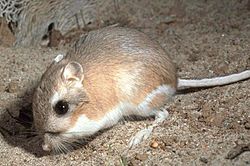Kangaroo rat facts for kids
Quick facts for kids Kangaroo ratTemporal range: Late Pliocene - Recent
|
|
|---|---|
 |
|
| Scientific classification | |
| Kingdom: | |
| Phylum: | |
| Class: | |
| Subclass: | |
| Order: | |
| Family: | |
| Genus: |
Dipodomys
Gray, 1841
|
Kangaroo rats are small rodents from North and Central America. They got their name, because they look like small kangaroos, when standing upright. But they are not related to kangaroos, except that they are mammals.
Currently, there are 22 species in that genus. They vary in size from 10cm to 20cm, and weight between 35 and 180 grams for adult animals.
Contents
Appearance
- Size: Kangaroo rats are small, usually about 4 to 6 inches long, not including their tail.
- Tail: Their tail is even longer than their body, often 5 to 8 inches long, and it has a tuft of fur at the end. This tail helps them balance when they hop.
- Fur: They have soft fur that is usually a sandy or brownish color, which helps them blend in with the desert ground.
- Legs: Their back legs are much longer and stronger than their front legs, which is what allows them to hop.
- Eyes: They have big eyes that help them see well at night.
Habitat
Kangaroo rats live in dry climates.They can live in deserts also, like Thar Desert. This means that they have developed traits to other species that live in such climates, but are not related to them. Some of those species are the jerboas, which can be found in the deserts of Africa and Asia, and the hopping mice of the Australian Outback.
Kangaroo mice are found in areas if the United States and Mexico, where there is some grass or vegetation left, but which have a rather dry climate. Scientists call those areas arid and semi-arid.
Here are some states where you can find them:
They build their homes in burrows, which are tunnels in the ground. These burrows help protect them from the hot sun during the day and from predators at night.
Diet
The animals live on seeds, leaves, nuts and other fruit they can find. They also catch insects. They are also known for stockpiling (keeping) some food in their burrows, for bad times.
One of the coolest things about kangaroo rats is that they don't need to drink water! They get all the water they need from the seeds they eat. Their bodies are super good at saving water, which is important in the dry places where they live.
Behavior
Kangaroo rats are nocturnal, which means they are most active at night. During the day, they stay in their burrows to avoid the heat and predators. Here are some interesting things about their behavior:
Hopping: They hop around on their back legs to move quickly. They can jump pretty far, which helps them escape from predators.
Burrowing: They dig complex burrows with different rooms for sleeping, storing food, and raising their babies.
Cheek Pouches: They have fur-lined pouches in their cheeks that they use to carry seeds. These pouches can hold a lot of seeds!
Dust Baths: Kangaroo rats keep their fur clean by taking dust baths. They roll around in the dirt to get rid of oil and dirt.
Territorial: They are territorial, which means they defend their burrows and the area around them from other kangaroo rats.
Unlike many other animals, kangaroo rats don't sweat or pant to stay cool. This helps them avoid losing water.
Types
There are many different types of kangaroo rats, but here are a few of the most common ones:
- Ord's Kangaroo Rat (Dipodomys ordii): This is one of the most common kangaroo rats. They are found in many different habitats, from grasslands to deserts.
- Merriam's Kangaroo Rat (Dipodomys merriami): These kangaroo rats are smaller than Ord's kangaroo rats and are found in the southwestern United States and Mexico.
- Desert Kangaroo Rat (Dipodomys deserti): As their name suggests, these kangaroo rats live in very dry deserts. They are larger than other kangaroo rats and have very pale fur.
- Banner-tailed Kangaroo Rat (Dipodomys spectabilis): These kangaroo rats are known for their large tails with a white "banner" at the end. They build large mounds of dirt around their burrows.
Predators
The desert can be a dangerous place, and kangaroo rats have many predators, including:
Why are kangaroo rats important?
Kangaroo rats play an important role in their ecosystem. Here are some ways they help the environment:
- Seed Dispersal: When they collect seeds and store them, they sometimes bury them and forget about them. These seeds can then grow into new plants.
- Soil Aeration: When they dig their burrows, they help mix up the soil, which makes it better for plants to grow.
- Food Source: They are a food source for other animals like owls, snakes, and coyotes.
Conservation
The wild status of most kangaroo rat species is good right now. However, some species are endangered because they have lost much of their habitat. For example, the giant kangaroo rat and the Stephens' kangaroo rat are both threatened by habitat loss due to agriculture, urbanization, and suburban development.
Fun facts about kangaroo rats
- Kangaroo rats can jump up to 9 feet in a single bound!
- They can hear very low-frequency sounds, which helps them detect predators.
- They can close their ears to keep sand out when they are digging.
- They live in deep burrows that protect them from the worst heat of the day.
- They only rarely need to drink water. Instead, they have a very efficient metabolism. They can chemically split off water from the food they eat.
- They can live for up to 5 years in the wild.
Scientific Classification
Kingdom: Animalia
Phylum: Chordata (they have a backbone)
Class: Mammalia (they are mammals, like us!)
Order: Rodentia
Family: Heteromyidae
Genus: Dipodomys
Images for kids
-
Tipton kangaroo rat (D. nitratoides nitratoides) at the California Living Museum in Bakersfield
See also
 In Spanish: Ratas Canguro para niños
In Spanish: Ratas Canguro para niños


